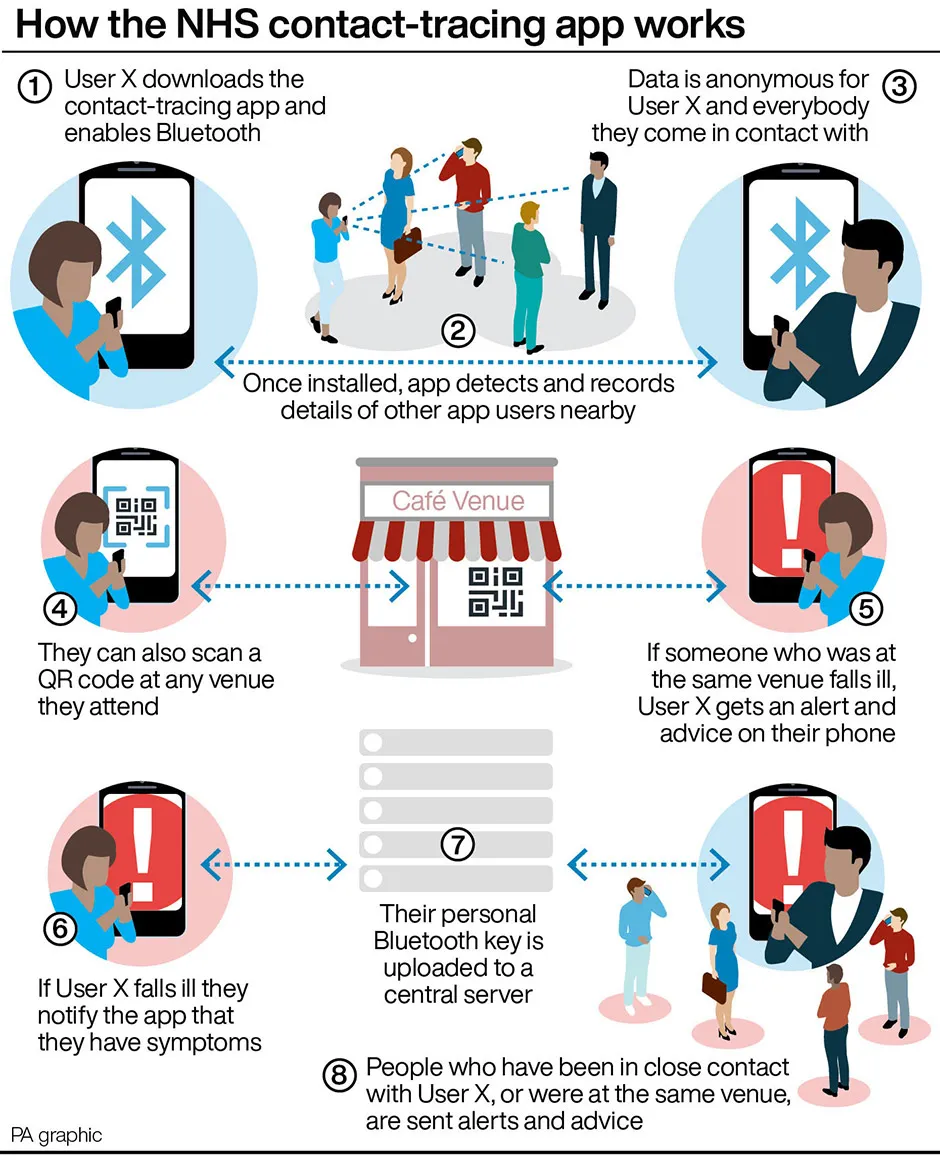A coronavirus contact-tracing app is launching across England and Wales on 24 September in what the Health Secretary has called “an important step forward” in our fight against the “invisible killer”.
The rollout follows months of delay and questions about its effectiveness in the face of mixed results from other countries which have already deployed such apps.
NHS Test and Trace, which is responsible for the service, said the app was used to send alerts to users during a trial period on the Isle of Wight and in the London borough of Newham, after people had tested positive.
The latest version was piloted among residents of both areas as well as NHS volunteers from mid-August, after the first app was marred by technical issues and eventually scrapped.
Read more about contact tracing:
- COVID-19: Second wave could be twice as high without contact tracing
- Coronavirus: contact tracing app could stop spread if 80 per cent use it
As the software is voluntary, its success will also depend heavily on how many people choose to download and use it.
An advertising campaign to promote the app will appear on television with the strapline, “Protect your loved ones. Get the app”.
It comes at a critical time for the UK, with confirmed cases of COVID-19 on the rise daily.
“We are at a tipping point in our efforts to control the spread of this virus,” said Health and Social Care Secretary Matt Hancock.“With infection rates rising we must use every tool at our disposal to prevent transmission, including the latest technology.
“We have worked extensively with tech companies, international partners, and privacy and medical experts – and learned from the trials – to develop an app that is secure, simple to use and will help keep our country safe."

“Today’s launch marks an important step forward in our fight against this invisible killer and I urge everyone who can to download and use the app to protect themselves and their loved ones,” Hancock said.
The app uses an Apple and Google-developed system, using Bluetooth to keep an anonymous log of people a user has been close to.It does this by exchanging randomised keys while the Bluetooth signal strength measures proximity.
If someone falls ill, they can tell the app, which will then ping their keys to a central server and in turn send them off to all app users in search of a match.Should the system determine a person as a close contact, they will be automatically sent a notification and issued with further guidance.
Read the latest coronavirus news:
- Coronavirus: Imperial vaccine could be approved by mid-2021
- COVID-19: Around 20 per cent of cases are asymptomatic
A QR code scanning feature is available, allowing people to check-in to venues they visit and easily share their contact details for human tracing efforts.Some 160,000 businesses have already downloaded QR codes for use in their facilities.
“We want to make it as easy as possible for everyone to engage with England’s NHS Test and Trace service," said Baroness Dido Harding, executive chair of England’s NHS Test and Trace Programme.
“The features of this app, including QR code check-in at venues, work alongside our traditional contact tracing service and will help us to reach more people quickly in their communities to prevent further spread of the virus."
The UK’s major network operators, including Vodafone, Three, EE and O2, giffgaff, Tesco Mobile, Sky Mobile and Virgin Mobile have agreed to “zero-rate” data charges incurred by all in-app activity, meaning their customers will not be charged for using it.
How can I protect myself from the coronavirus when shopping?
You’ll have seen signs in your local supermarket advising you to keep two metres from others while moving around the store. This is key to reducing your chances of catching the virus while shopping.
The coronavirus SARS-CoV-2 is spread through respiratory droplets that leave our mouth and nose when we cough, sneeze, or sometimes even talk. The droplets sprayed out by an infected person will contain the virus, which could then enter your body via your mouth, nose or eyes (this is why you shouldn’t be touching your face).
Respiratory droplets don’t usually travel more than one metre, so by keeping two metres from others, you’ll reduce the likelihood of being in the firing line. To make it easier to keep your distance, try to shop during off-peak hours, choose a store that’s limiting the number of people who can be inside at any one time, and use self-checkout if you can.
Keeping your hands clean is the other main thing you can do. If possible, wipe the trolley or basket handles with a disinfectant wipe when you arrive at the store. When you get home, wash your hands or use hand sanitiser before and after unpacking your bags.
A US study found that the coronavirus can survive for up to 24 hours on cardboard, and up to three days on hard, shiny surfaces such as plastic, so wiping down your purchases with a disinfectant spray or a soapy cloth before you put them away is another good habit to get into.
Read more: